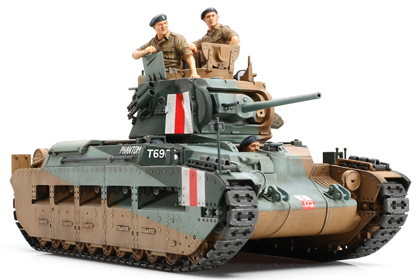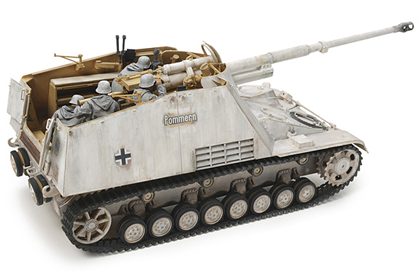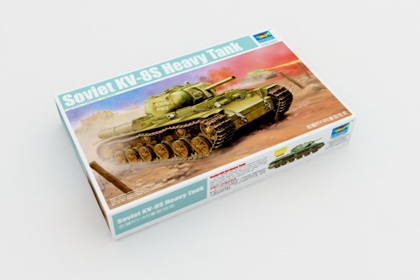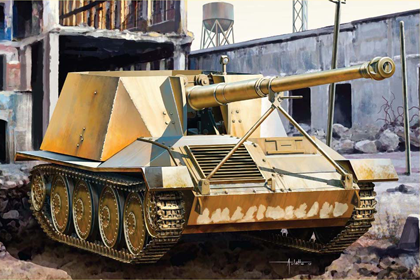![]()
This is the Eduard, photo etch sets for the ‘British Mathilda MK.III/IV‘ from Tamiya.
Detail set |
Tamiya |
||||
| (36 094) | Interior | 35 500 | ✓ | ||
| (36 110) | Rear plating | ✓ | |||
Source: Eduard

This is the Voyager Model, photo etch sets for the ‘British Matilda MK.III/IV‘ from Tamiya.
Detail set |
Tamiya |
||||
| (35 300) | Basic | 35 300 | |||
Source: Voyager Model
This is the Tamiya 35 300 kit in 1/35 scale, of the ‘British Matilda MK.III/IV’.

The Matilda swept aside Italian opponents and was respectfully called the “Queen of the Desert” by German forces. During Operation Battleaxe to lift the siege of Tobruk in June 1941, German forces famously used their 88mm AA guns in the anti-tank role as they were the only effective counter against Matildas.
The Matilda has written her name into the history books as a highly effective tank which continually proved her worth during many fierce battles throughout North Africa.
This is the Tamiya 35335 kit in 1/35 scale, of the ‘German Self-Propelled Heavy Anti-Tank Gun Nashorn’.

While deployment started in July 1943 under the moniker of Hornisse, it was given the new Nashorn designation from January of the next year, reportedly at the command of Hitler. 439 units were produced up to March 1945, and they served on both the Eastern and Western Fronts, providing heavy firepower for German forces.
This is the MiniArt 35162 kit in 1/35 scale, of the ‘German Pz.Kpfw.III Ausf. B’.

The Ausf. В was the second attempt at a design solution for a tank in the 15-ton class. Only a small number of these design series vehicles were produced to provide a gun-armed Pz.Kpfw for training.
The design of the suspension of the Ausf. В was completely different from that of the Ausf. A. In place of the five road wheels with coil springs, the Ausf. В had eight road wheels per side, divided into pairs, with long leaf springs supporting a pair of road wheels at each end. Further improvements were made by increasing the number of return rollers to three, redesigning the cupola, and altering the rear deck and engine air louvres.
The Ausf. В were issued to Panzer units in 1937. After action in Poland, they were all removed from combatant units in February 1940 because of their unsatisfactory suspension and 15mm armour. In October 1940, the five Ausf. В Fahrgestell, which had been used for the experimental (0-Serie) series of the Sturmgeschütz, were returned to the Armoured troops and used as training vehicles.

Aftermarket working plastic track links for my British vehicles, in 1/35 scale.
Please verify the vendor’s website, before using the information below
Cruiser |
|||||||
| Cromwell, Mk.IV | SK-49 | ||||||
| Crusader | |||||||
| Comet | |||||||
Infantry |
|||||||
| Valentine | |||||||
| Matilda, Mk.II | |||||||
| Matilda, Mk.III/IV | |||||||
Main |
|||||||
| Centurion | |||||||
| Challenger 1 | |||||||
| Chieftain | |||||||
Heavy |
|||||||
| Churchill | |||||||
Artillery |
|||||||
| Archer | |||||||
| Bishop |
Source: Modelkasten
This is the Trumpeter 01572 kit in 1/35 scale, of the ‘Russian Heavy Tank KV-8S’.

This is the Trumpeter 05586 kit in 1/35 scale, of the ‘Russian Heavy Tank JS-7’.

Although it was in many ways an innovative design, it was never accepted for mass production due to its cumbersome size and the very impractical layout of its fighting compartment
This is the Dragon 6728 kit in 1/35 scale, of the ‘German Ardelt-Rheinmetall 8.8cm PaK 43 Waffenträger’.

The vehicle’s engine was fitted at the front of the hull, which permitted the main armament – an 8.8cm L/71 cannon – to be fitted on the rear. It utilized a 38(t) chassis with four road wheels per side. An improved prototype (Ardelt II) was later produced by Ardelt and Krupp, but the end of the war intervened before production got off the ground.

Aftermarket working plastic track links for my American vehicles, in 1/35 scale.
Please verify the vendor’s website, before using the information below
Light |
|||||||
| M3 Stuart | SK-53 | ||||||
| M24 Chaffee | SK-63 | ||||||
| M41 Walker Bulldog | |||||||
| M551 Sheridan | |||||||
Medium |
|||||||
| M4 Sherman | SK-44 | SK-45 | SK-48 | SK-55 | SK-64 | SK-73 | |
| M46/M47/M48/M60 Patton | |||||||
| M1 Abrams | |||||||
Heavy |
|||||||
| M26 Pershing | |||||||
Destroyer |
|||||||
| M18 Hellcat | SK-41 | ||||||
Artillery |
|||||||
| M44 Howitzer | |||||||
| M53/M55 Howitzer |
Source: Modelkasten
This is the Ace, photo etch sets for the ‘Russian Self Propelled Gun, SU-76M‘ from MiniArt.
Detail set |
Alan/DML |
||||
| (3501) | Basic, SU-76M† | ✓ | |||
Source: Ace Model